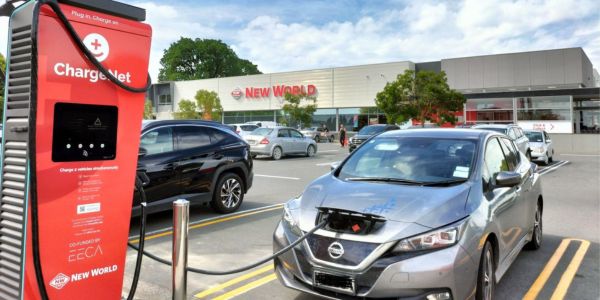DC = direct current, meaning that the current only moves in one direction. DC current is used for power transmission over great distances because it leads to less inductive losses.
DC Charging indicates using an offboard charger, that is, a charger located at the charging station, and not in the vehicle.
DC stations in New Zealand have a tethered charging cable. The NZTA recommends that DC charging stations provide tethered cables with both the CHAdeMo DC and DC CCS Type 2 (a sort of multi fit port) connector type.
You won’t be able to get a fast charge at a DC public charging station if your car doesn’t have the matching DC charging port/inlet.
- You select the compatible supply cable and connector from the charging station and connect this to the electric vehicle inlet.
- The driver may then need to activate the power supply by using a start button on the charging station, radio-frequency identification (RFID) tag, swipe card, smart phone app or other device.
- Charging will start once access has been accepted and communication between the vehicle and the charger is established.

Does DC charge faster than AC?
Yes DC power is much faster than an AC charging station as there is less resistance for the current of electricity. However, the disadvantage of DC is that it is much more expensive to install than an AC charging station.
The rate a DC public charger will charge your car depends on the capacity of your onboard charger.
Factors affecting the rate of charge
The amount of time needed to completely charge an electric vehicle depends on several factors, including:
- battery capacity
- ambient temperature
- utility/grid constraints limiting the current available to the charging station
- temperature of the charging station
- charging type
- the vehicle’s battery management system (BMS)
- the capability of the on-board charger
- the amperage of the charging station
The amount of charge already in the battery also affects the speed at which a battery can recharge – the closer it is to empty, the faster the electricity can flow.
When a battery is charged to 80 percent the charging rate typically starts to taper off. Therefore, if a driver is paying by the minute at a fast charge station, it can become costly to charge over 80 percent and they may not wish to completely fill up.
Can I get DC ‘fast’ charging at home?
The short answer is no. A DC fast charger is designed for industrial and commercial settings. This is mostly due to the power requirements and expenses associated with a Level 3 charger.